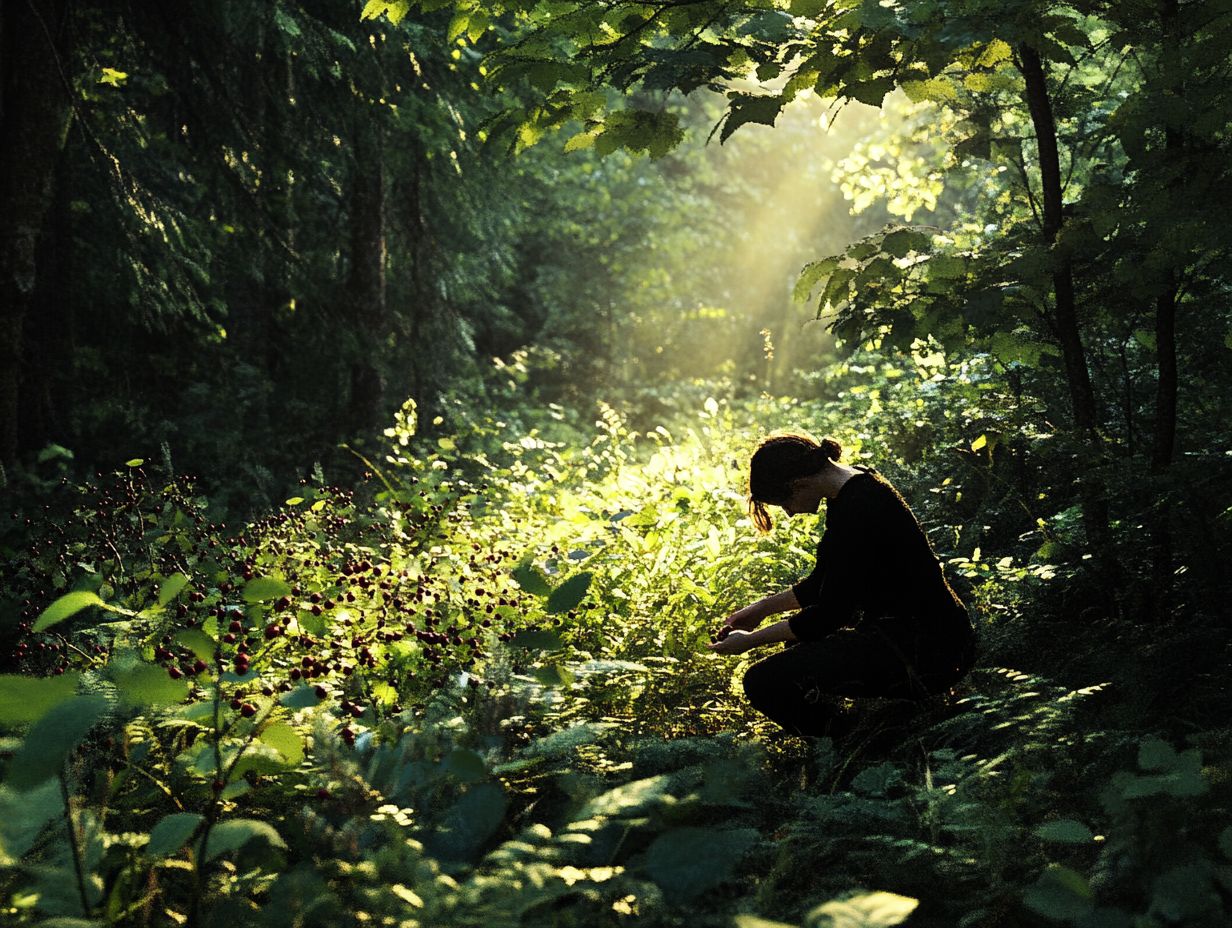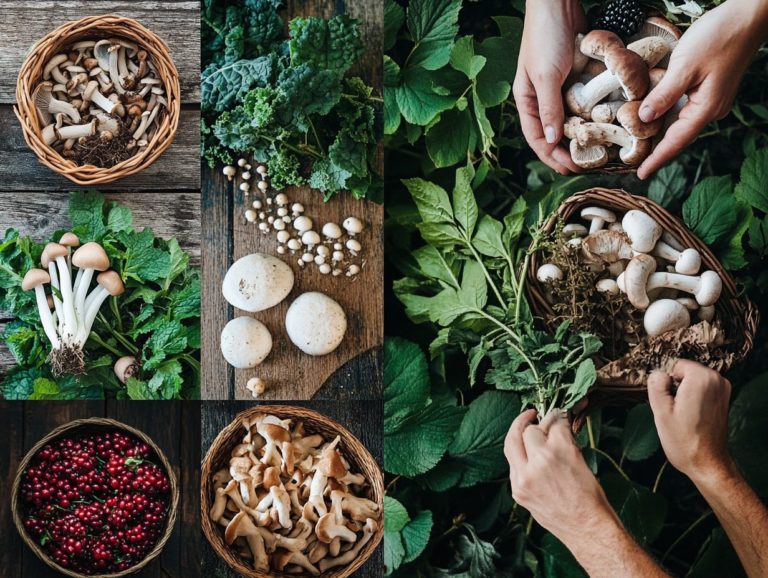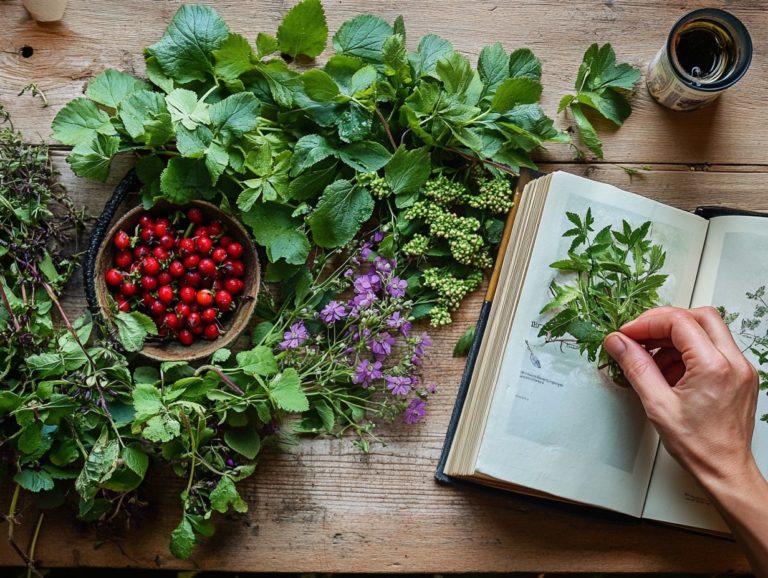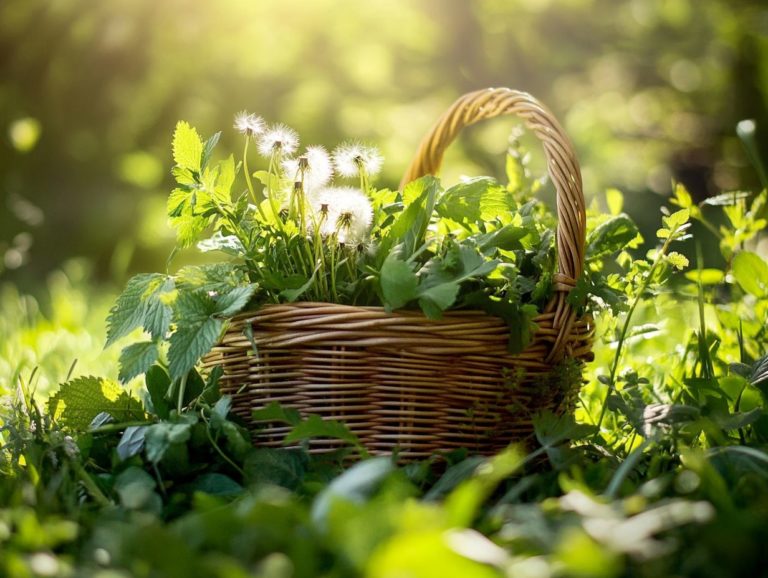Foraging for Wild Berries: Seasonal Tips
Foraging for wild berries has evolved into a cherished pastime, enticing nature enthusiasts and food lovers alike to immerse themselves in the beauty of the outdoors.
This article delves into the fascinating world of foraging, beginning with an exploration of common wild berries and the art of identifying them. You ll uncover the optimal times and locations to discover these delectable fruits, alongside essential safety tips to ensure a secure foraging experience.
It also covers effective techniques for harvesting, cooking ideas, and methods to preserve your delightful bounty. Whether you’re a seasoned forager or a curious novice, there s something here that will captivate your interest.
Contents
Key Takeaways:

- Know the seasonal availability and ideal environments for wild berries to increase your chances of successfully berry foraging.
- Take safety precautions and be aware of potential hazards when foraging for wild berries, such as poisonous look-alikes and wildlife encounters.
- Wild berries have a variety of uses, from cooking to medicinal, and can be preserved and stored for long-term use using different methods.
What is Foraging and Why is it Popular?
Foraging, which means searching for and collecting wild edible plants, is booming in popularity, inviting everyone to discover the joys of nature. You can explore your surroundings while appreciating the wealth of edible wild foods waiting to be discovered, including wild greens and edible flowers.
This trend not only deepens your understanding of local flora but also encourages sustainable practices and environmental awareness. Engaging in foraging workshops and community events equips you with valuable skills like plant identification, foraging techniques, and wild harvesting.
As you seek to reconnect with nature, foraging presents itself as a truly rewarding outdoor activity, particularly when engaging in nature appreciation activities.
Common Types of Wild Berries
You’ll find that some of the most delightful wild berries include exquisite options like raspberries, elderberries, and blackberries. These enticing varieties beckon berry hunters, inviting them to delve into the seasonal bounty offered by local ecosystems. For more information, check out the seasonal guide foraging through the year during the lush berry season.
Exploring this fruitful landscape is not just a feast for the palate but also an enriching experience for the soul.
Identifying and Differentiating Wild Berries
Identifying and differentiating wild berries is essential for successful foraging, as some berries can be toxic. A reliable foraging guide, like identifying wild berries: what you need to know, is crucial for both novice and experienced foragers alike to navigate the complexities of wild food preparation.
Understanding the various characteristics of berries can significantly enhance your foraging experience. Observing color variations like vibrant reds, deep purples, or striking blacks provides vital clues about their identity. The shape of the berries, whether round, elongated, or oblong, can further narrow down your options. Pay attention to growth patterns as well; whether the berries grow in clusters or along single stems can be pivotal in proper identification.
Familiarizing yourself with local toxic plants is paramount; knowing these can help you avoid harmful mistakes. Here are some safe foraging tips to keep in mind:
- Use gloves to prevent skin contact with potentially harmful species.
- Always consult multiple reliable sources before consuming any wild berry.
When and Where to Find Wild Berries
Understanding when and where to seek out wild berries is crucial for a successful berry-hunting experience. Referencing a seasonal guide for foraging techniques can help you learn that different species flourish in particular seasonal conditions and environments, which can vary greatly depending on the local flora and climate.
Being aware of these nuances can elevate your foraging skills and enhance the joy of your harvest.
Seasonal Availability and Ideal Environments

The seasonal availability of wild berries hinges on various factors, including climate and geographical location. For those interested in gathering, understanding the best times to gather wild edibles is essential, as certain species thrive in specific environments that meet their growth requirements.
In temperate regions, berries like blackberries and raspberries flourish in sunny, well-drained areas, often found in hedgerows or forest edges. Moisture-loving species such as blueberries prefer acidic soils, typically located in boggy landscapes.
Weather patterns are also important. A warm, wet spring can lead to plenty of berries, while frost during flowering can seriously affect your yield.
As an avid forager, being aware of local weather forecasts and seasonal cycles boosts your chances of finding delicious berries. To enhance your foraging strategy, refer to seasonal foraging: the best times to gather edibles, which can help you plan your berry-picking trips more effectively.
Safety Considerations for Foraging
Safety is crucial when foraging. Stay alert for potential hazards, such as toxic plants, while also practicing responsible foraging to ensure sustainability.
This approach safeguards your well-being and honors nature’s delicate balance.
Potential Hazards and Precautions
Potential hazards in foraging can appear unexpectedly, from toxic plants and allergic reactions to environmental dangers. It’s essential to adopt safe foraging practices and take the right precautions.
Stay aware of your surroundings to avoid risks; injuries from uneven terrain or sudden weather changes can pose serious threats. Equip yourself with essential tools such as:
- A sturdy knife for harvesting,
- A field guide for identifying plants,
- Containers for safely storing your prized finds.
Carrying a basic first aid kit is invaluable for addressing minor injuries or allergic reactions on the spot. Most importantly, staying vigilant and informed while exploring the wild enhances your foraging experience and minimizes potential threats.
Foraging Tips and Techniques
Foraging tips and techniques can truly elevate your wild harvesting experience. They offer practical strategies to identify edible plants, understand the plant body parts, and master the art of seed harvesting.
Embracing these methods transforms foraging into not just a skill, but an enriching adventure.
Best Practices for Successful Foraging
Adopting best practices for successful foraging helps you forage safely and sustainably while enjoying the benefits of community foraging and wildcrafting, or gathering plants for food or medicine.
By honing your skills in accurately identifying edible plants, you get to savor the unique flavors of wild cuisine and cultivate a profound respect for the environment.
Engaging with seasoned foragers through local workshops or community groups unveils essential insights about seasonal shifts and regional ecosystems that you might not have considered.
Stories about preserving natural habitats while harvesting highlight the importance of sustainability. Foragers often emphasize their commitment to taking only what they need, ensuring there’s plenty left for wildlife and future growth.
This caring approach helps you connect more deeply with nature!
Uses for Wild Berries

Wild berries offer an impressive array of uses, seamlessly transitioning from delightful culinary creations like jams and desserts to their role in medicinal practices, including health benefits.
By incorporating these vibrant fruits into your life, you can enhance both your diet and your well-being, elevating your foraging adventures into enriching experiences.
We invite you to share your own foraging experiences and tips to enrich our community!
Culinary and Medicinal Applications
The culinary and medicinal applications of wild berries showcase their versatility. These remarkable natural foods can be transformed into delightful dishes or used as herbal remedies in traditional medicine, promoting well-being through nature’s gifts.
Consider elderberries and blackberries. They shine as exquisite ingredients in jams, jellies, and desserts. They also offer numerous health benefits, including immune support and anti-inflammatory properties. These berries are foundational to many wild food preparation recipes.
To savor the bounty of these berries, explore various preparation methods. You could craft berry-infused syrups or even ferment them for probiotic goodness.
For long-term storage, options like freezing or dehydrating preserve rich flavors and ensure that their health benefits stay intact. This gives you year-round access to these little powerhouses for culinary adventures and enhances your health.
Preserving and Storing Wild Berries
Preserving and storing wild berries is crucial for enjoying their delightful flavors and health benefits long after the berry season ends. This practice lets you enjoy delicious flavors all year round!
Methods for Long-Term Use
Enjoying wild berries long-term involves various preservation techniques that maintain their delightful flavor and health benefits. To master these methods, consider exploring seasonal foraging techniques, ensuring you can savor these foraged gems all year round.
Among these techniques, freezing is arguably the simplest and most effective way to lock in the essence of wild berries. Start by gently washing the berries and letting them air dry to remove excess moisture.
Once they re dry, lay them flat on a baking sheet and pop them in the freezer. This helps prevent clumping and keeps your berries ready for use.
Vacuum sealing removes air to minimize freezer burn while preserving delicious flavor. If you re feeling adventurous, canning might be your calling. By combining berries with sugar and pectin, you can create jams or preserves that add a sweet touch to many dishes.
Each method offers unique advantages. Consider your personal preferences and the equipment you have on hand.
Frequently Asked Questions
When should I forage for wild berries?

The best time to forage for wild berries is typically during the summer months when most berries are ripe for picking. For those interested in expanding their foraging skills, understanding techniques for harvesting wild grains can also enhance your seasonal foraging experience.
What should I bring when foraging for wild berries?
It is important to bring a few key items, such as a small basket or container, gardening gloves, and a guidebook or smartphone app to identify different types of berries.
Can I eat all types of wild berries I find?
No, not all wild berries are safe to eat. Properly identify each berry type before consuming. If unsure, it s best to avoid eating it.
What safety precautions should I take while foraging?
Yes, wear protective clothing to avoid scratches or stings from plants or insects. Avoid foraging near roadsides, as berries close to highways may be exposed to pollutants.
What popular wild berries should I look for?
Some popular wild berries include blackberries, blueberries, raspberries, strawberries, and elderberries. The types of berries available can vary by location and season.
How can I forage ethically and sustainably?
To forage ethically and sustainably, take only what you need and leave some for wildlife and other foragers. Do not disturb the natural environment, and follow guidelines set by local conservation organizations.
Ready to start your berry foraging adventure? Enjoy the flavors and health benefits of the best wild fruits to forage in summer!






![The Best Locations for Winter Foraging in [Your Area]](https://forageadept.com/wp-content/uploads/2024/08/the-best-locations-for-winter-foraging-in-your-area-jI-768x578.jpeg)